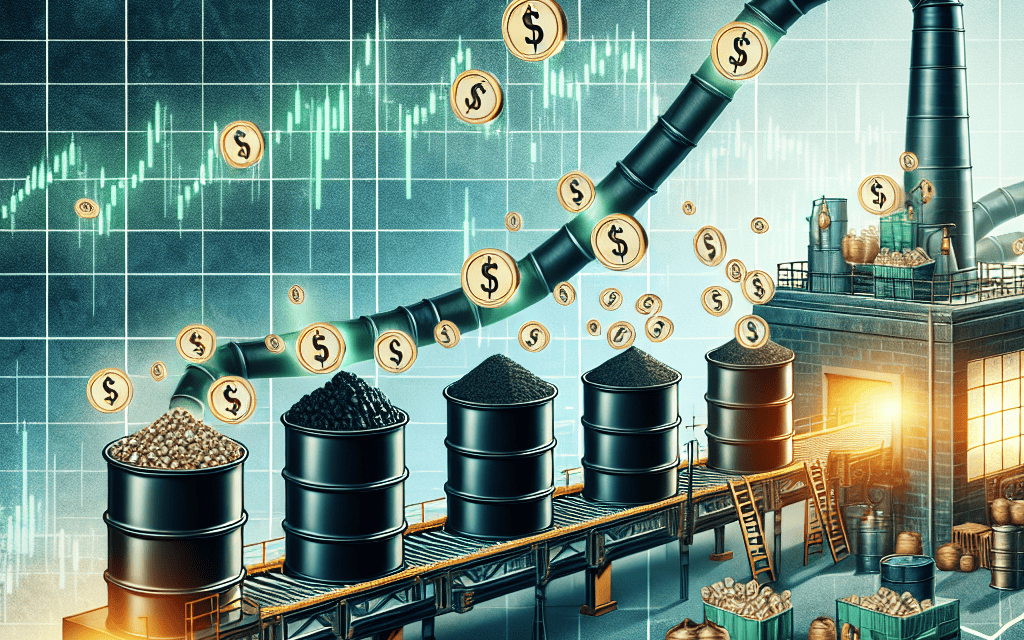“Power Up Your Portfolio: High-Yield Energy Stocks Driving Dynamic Growth”
Introduction
High-yield energy stocks have emerged as a compelling investment avenue for those seeking robust growth and consistent income in an ever-evolving market landscape. These stocks, often characterized by their attractive dividend yields, represent companies within the energy sector that are not only committed to returning value to shareholders but are also strategically positioned to capitalize on global energy demands. As the world transitions towards more sustainable energy solutions, these companies are adapting and innovating, ensuring they remain at the forefront of the industry. By investing in high-yield energy stocks, investors can potentially benefit from the dual advantage of capital appreciation and regular income, making them a vital component of a diversified investment portfolio.
Analyzing Top High-Yield Energy Stocks for Long-Term Growth
In the ever-evolving landscape of the energy sector, high-yield energy stocks have emerged as a compelling option for investors seeking robust long-term growth. These stocks, often characterized by their attractive dividend yields, offer a unique blend of income and potential capital appreciation. As the global demand for energy continues to rise, driven by both traditional and renewable sources, high-yield energy stocks present a promising opportunity for investors aiming to capitalize on this growth trajectory.
To begin with, the energy sector is undergoing a significant transformation, with a shift towards cleaner and more sustainable energy sources. This transition is not only reshaping the industry but also creating new avenues for growth. Companies that are strategically positioned to adapt to these changes are likely to experience substantial growth in the coming years. High-yield energy stocks, particularly those involved in renewable energy, are at the forefront of this transformation. These companies are investing heavily in technologies such as wind, solar, and bioenergy, which are expected to play a crucial role in the global energy mix.
Moreover, the financial stability of high-yield energy stocks is another factor that makes them attractive for long-term growth. Many of these companies have strong balance sheets and generate consistent cash flows, enabling them to maintain and even increase their dividend payouts. This financial resilience is particularly important in the energy sector, which is often subject to volatile commodity prices and regulatory changes. By focusing on companies with a proven track record of financial performance, investors can mitigate some of the risks associated with the sector.
In addition to their financial stability, high-yield energy stocks often benefit from favorable macroeconomic trends. For instance, the global push towards reducing carbon emissions is driving significant investment in renewable energy infrastructure. Governments around the world are implementing policies and incentives to support the development of clean energy projects, which in turn boosts the growth prospects of companies involved in this space. As a result, high-yield energy stocks that are aligned with these trends are well-positioned to deliver strong returns over the long term.
Furthermore, diversification within the energy sector can enhance the growth potential of high-yield energy stocks. By investing in a mix of traditional and renewable energy companies, investors can benefit from the stability of established oil and gas firms while also capturing the growth potential of emerging renewable energy technologies. This balanced approach allows investors to navigate the complexities of the energy market and capitalize on opportunities across different segments.
It is also worth noting that high-yield energy stocks can serve as a hedge against inflation. As energy prices tend to rise with inflation, companies in this sector often experience increased revenues, which can lead to higher dividend payouts. This characteristic makes high-yield energy stocks an attractive option for income-focused investors seeking to preserve their purchasing power over time.
In conclusion, high-yield energy stocks offer a compelling combination of income and growth potential, making them an attractive option for long-term investors. By focusing on companies that are well-positioned to capitalize on the ongoing transformation of the energy sector, investors can benefit from both the stability of traditional energy sources and the growth potential of renewable technologies. As the global demand for energy continues to evolve, high-yield energy stocks are poised to play a pivotal role in fueling robust growth for investors.
The Role of Dividends in High-Yield Energy Stock Investments
In the realm of investment, high-yield energy stocks have emerged as a compelling option for investors seeking both income and growth. These stocks, often characterized by their substantial dividend payouts, play a pivotal role in the portfolios of those looking to balance risk and reward. Dividends, the periodic payments made to shareholders from a company’s earnings, serve as a crucial component in the overall appeal of high-yield energy stocks. They not only provide a steady income stream but also reflect the financial health and stability of the issuing company. As the energy sector continues to evolve, understanding the role of dividends in high-yield energy stock investments becomes increasingly important.
To begin with, dividends offer investors a tangible return on their investment, independent of stock price fluctuations. This is particularly significant in the energy sector, where market volatility can be pronounced due to factors such as geopolitical tensions, regulatory changes, and shifts in global demand. By providing a consistent income, dividends help mitigate the impact of such volatility, offering investors a degree of financial predictability. Moreover, companies that consistently pay dividends are often perceived as financially stable, as they demonstrate an ability to generate sufficient cash flow to reward shareholders. This perception can enhance investor confidence, further bolstering the attractiveness of high-yield energy stocks.
Furthermore, dividends can play a strategic role in an investor’s portfolio by contributing to the compounding effect. When dividends are reinvested, they purchase additional shares, which in turn generate more dividends. Over time, this compounding can significantly enhance the total return on investment, making high-yield energy stocks an appealing choice for long-term investors. This strategy is particularly effective in the energy sector, where companies often have substantial capital expenditures and long project timelines. By reinvesting dividends, investors can capitalize on the sector’s growth potential while benefiting from the steady income stream that dividends provide.
In addition to their financial benefits, dividends also serve as a signal of corporate governance and management quality. Companies that prioritize dividend payments often exhibit disciplined financial management and a commitment to shareholder value. This is especially relevant in the energy sector, where capital allocation decisions can have far-reaching implications. By maintaining a consistent dividend policy, energy companies demonstrate their ability to balance growth initiatives with shareholder returns, thereby reinforcing investor trust.
However, it is important to recognize that not all high-yield energy stocks are created equal. Investors must conduct thorough due diligence to assess the sustainability of dividend payments. Factors such as the company’s debt levels, cash flow generation, and capital expenditure requirements should be carefully evaluated. Additionally, external factors such as commodity price fluctuations and regulatory changes can impact a company’s ability to maintain its dividend payouts. Therefore, a comprehensive analysis of both the company’s fundamentals and the broader market environment is essential for making informed investment decisions.
In conclusion, dividends play a multifaceted role in high-yield energy stock investments, offering both financial benefits and insights into corporate governance. They provide a steady income stream, contribute to the compounding effect, and signal management quality, all of which enhance the appeal of these stocks. As the energy sector continues to navigate a complex landscape, dividends remain a key consideration for investors seeking to balance income and growth. By understanding the nuances of dividend payments and conducting thorough due diligence, investors can effectively harness the potential of high-yield energy stocks to fuel robust growth in their portfolios.
How Renewable Energy Stocks Are Transforming High-Yield Portfolios
In recent years, the landscape of high-yield portfolios has undergone a significant transformation, driven largely by the burgeoning sector of renewable energy stocks. As investors increasingly seek sustainable and environmentally responsible options, renewable energy companies have emerged as attractive candidates for high-yield portfolios. This shift is not only reshaping investment strategies but also contributing to the broader transition towards a more sustainable global economy.
To begin with, the growing emphasis on environmental, social, and governance (ESG) criteria has played a pivotal role in the rise of renewable energy stocks within high-yield portfolios. Investors are now more conscious of the impact their investments have on the environment and society. Consequently, they are gravitating towards companies that align with these values. Renewable energy firms, which focus on harnessing natural resources such as wind, solar, and hydroelectric power, are inherently aligned with ESG principles. This alignment has made them particularly appealing to investors who prioritize sustainability alongside financial returns.
Moreover, the global push for decarbonization and the reduction of greenhouse gas emissions has further accelerated the growth of renewable energy stocks. Governments worldwide are implementing policies and incentives to promote clean energy adoption, creating a favorable environment for renewable energy companies to thrive. These policy measures, coupled with technological advancements, have significantly reduced the cost of renewable energy production, making it more competitive with traditional fossil fuels. As a result, renewable energy companies are experiencing robust growth, which in turn is attracting investors seeking high-yield opportunities.
In addition to policy support, the financial performance of renewable energy companies has been impressive. Many of these firms have demonstrated strong revenue growth and profitability, driven by increasing demand for clean energy solutions. This financial strength has enabled them to offer attractive dividends, making them appealing to income-focused investors. Furthermore, the long-term contracts often secured by renewable energy companies provide a stable revenue stream, enhancing their appeal as reliable high-yield investments.
Transitioning to the broader market dynamics, it is important to note that the renewable energy sector is not immune to challenges. Fluctuations in energy prices, regulatory changes, and technological disruptions can impact the performance of renewable energy stocks. However, the sector’s resilience and adaptability have been evident in its ability to navigate these challenges. For instance, the diversification of energy sources and the expansion into emerging markets have provided renewable energy companies with new growth avenues, mitigating some of the risks associated with market volatility.
Furthermore, the integration of innovative technologies such as energy storage and smart grid solutions is enhancing the efficiency and reliability of renewable energy systems. These advancements are not only improving the operational performance of renewable energy companies but also increasing their attractiveness to investors seeking cutting-edge solutions in their portfolios. As these technologies continue to evolve, they are likely to further bolster the growth prospects of renewable energy stocks.
In conclusion, renewable energy stocks are playing an increasingly vital role in transforming high-yield portfolios. Their alignment with ESG principles, supported by favorable policy environments and strong financial performance, has made them compelling options for investors. While challenges remain, the sector’s resilience and ongoing innovation suggest a promising future. As the world continues to prioritize sustainability, renewable energy stocks are poised to fuel robust growth in high-yield portfolios, offering both financial returns and positive environmental impact.
Comparing High-Yield Energy Stocks: Oil vs. Natural Gas

In the ever-evolving landscape of energy investments, high-yield energy stocks have emerged as a compelling option for investors seeking robust growth and reliable income. Among these, oil and natural gas stocks stand out as prominent contenders, each offering unique advantages and challenges. As the global demand for energy continues to rise, understanding the nuances between these two sectors becomes crucial for making informed investment decisions.
Oil stocks have long been a staple in the energy sector, driven by the world’s reliance on petroleum products for transportation, manufacturing, and other essential industries. The oil market is characterized by its cyclical nature, with prices often influenced by geopolitical events, supply chain disruptions, and changes in global demand. Despite these fluctuations, oil companies have historically provided attractive dividends, making them a popular choice for income-focused investors. Moreover, advancements in extraction technologies, such as hydraulic fracturing and deep-water drilling, have enabled oil companies to access previously untapped reserves, thereby enhancing their production capabilities and potential for growth.
In contrast, natural gas stocks have gained prominence in recent years, largely due to the increasing emphasis on cleaner energy sources. Natural gas is often touted as a bridge fuel, offering a lower-carbon alternative to coal and oil while renewable energy infrastructure continues to develop. This shift towards cleaner energy has been bolstered by government policies and international agreements aimed at reducing carbon emissions. Consequently, natural gas companies have experienced significant growth, driven by rising demand for electricity generation, industrial use, and residential heating. Additionally, the development of liquefied natural gas (LNG) technology has opened new markets for natural gas producers, further enhancing their growth prospects.
When comparing oil and natural gas stocks, it is essential to consider the distinct risk factors associated with each. Oil stocks are often subject to greater volatility due to their sensitivity to geopolitical tensions and regulatory changes. For instance, conflicts in oil-rich regions or shifts in OPEC production quotas can lead to sudden price swings, impacting the profitability of oil companies. On the other hand, natural gas stocks may face challenges related to infrastructure constraints and competition from renewable energy sources. The construction of pipelines and LNG facilities requires significant capital investment, and any delays or regulatory hurdles can affect the growth trajectory of natural gas companies.
Despite these challenges, both oil and natural gas stocks offer compelling opportunities for investors. Oil companies with diversified operations and strong balance sheets are well-positioned to weather market fluctuations and capitalize on long-term demand growth. Similarly, natural gas companies that invest in expanding their LNG capabilities and enhancing their distribution networks are likely to benefit from the global shift towards cleaner energy.
In conclusion, the choice between high-yield oil and natural gas stocks ultimately depends on an investor’s risk tolerance, investment horizon, and outlook on the energy sector. While oil stocks offer the allure of high dividends and established market presence, natural gas stocks present a growth-oriented opportunity aligned with the global transition to sustainable energy. By carefully evaluating the strengths and weaknesses of each sector, investors can make strategic decisions that align with their financial goals and contribute to a diversified investment portfolio. As the energy landscape continues to evolve, staying informed about market trends and technological advancements will be key to navigating the complexities of high-yield energy investments.
The Impact of Global Energy Policies on High-Yield Stocks
The global energy landscape is undergoing a significant transformation, driven by evolving policies and a heightened focus on sustainability. This shift has profound implications for high-yield energy stocks, which are increasingly becoming attractive investment options. As governments worldwide implement policies aimed at reducing carbon emissions and promoting renewable energy sources, the energy sector is witnessing a paradigm shift. This transition is not only reshaping the industry but also influencing the performance and appeal of high-yield energy stocks.
To begin with, the push for cleaner energy has led to substantial investments in renewable energy projects. Governments are offering incentives and subsidies to encourage the development of wind, solar, and other renewable energy sources. Consequently, companies that are heavily invested in these areas are experiencing robust growth. High-yield energy stocks, particularly those associated with renewable energy, are benefiting from this trend. Investors are increasingly drawn to these stocks due to their potential for long-term growth and attractive dividend yields.
Moreover, the global commitment to reducing carbon footprints has prompted traditional energy companies to diversify their portfolios. Many oil and gas companies are investing in renewable energy projects to align with global energy policies and ensure their long-term viability. This strategic shift is enhancing the appeal of high-yield energy stocks, as these companies are perceived as more resilient and adaptable to changing market conditions. As a result, investors are more confident in the stability and growth prospects of these stocks.
In addition to diversification, technological advancements are playing a crucial role in the energy sector’s evolution. Innovations in energy storage, grid management, and efficiency are making renewable energy more viable and cost-effective. High-yield energy stocks that are at the forefront of these technological advancements are poised to benefit significantly. These companies are not only improving their operational efficiencies but also enhancing their competitive edge in the market. Consequently, investors are increasingly considering these stocks as a means to capitalize on the technological revolution within the energy sector.
Furthermore, geopolitical factors are influencing global energy policies and, by extension, high-yield energy stocks. The ongoing tensions in various regions have underscored the importance of energy security and independence. Countries are striving to reduce their reliance on foreign energy sources by investing in domestic renewable energy projects. This focus on energy independence is driving demand for high-yield energy stocks, particularly those involved in local renewable energy initiatives. Investors are recognizing the potential for stable returns in this context, further fueling interest in these stocks.
However, it is essential to acknowledge the challenges that accompany this transition. The shift towards renewable energy requires substantial capital investment and poses operational challenges for traditional energy companies. High-yield energy stocks may face volatility as companies navigate these complexities. Nonetheless, the long-term outlook remains positive, as the global commitment to sustainable energy is unwavering.
In conclusion, global energy policies are having a profound impact on high-yield energy stocks. The transition towards renewable energy, driven by government incentives, technological advancements, and geopolitical considerations, is reshaping the energy sector. High-yield energy stocks, particularly those aligned with these trends, are experiencing robust growth and attracting significant investor interest. While challenges remain, the potential for long-term growth and stability makes these stocks an appealing option for investors seeking to capitalize on the evolving energy landscape. As the world continues to prioritize sustainability, high-yield energy stocks are poised to play a pivotal role in fueling robust growth in the sector.
Strategies for Investing in High-Yield Energy Stocks Amid Market Volatility
In the ever-evolving landscape of financial markets, investors are constantly seeking strategies that not only preserve capital but also generate substantial returns. High-yield energy stocks have emerged as a compelling option for those looking to navigate the complexities of market volatility while capitalizing on robust growth opportunities. As the global demand for energy continues to rise, driven by both traditional and renewable sources, these stocks present a unique blend of income and growth potential that can be particularly appealing in uncertain economic times.
To begin with, high-yield energy stocks are typically characterized by their ability to offer attractive dividend yields, which can provide a steady income stream for investors. This is particularly advantageous during periods of market volatility, as dividends can help cushion the impact of fluctuating stock prices. Companies in the energy sector, especially those involved in the production and distribution of oil, natural gas, and renewable energy, often generate significant cash flows. This financial strength enables them to maintain or even increase dividend payouts, making them a reliable choice for income-focused investors.
Moreover, the energy sector is undergoing a transformative shift, with a growing emphasis on sustainability and renewable energy sources. This transition presents a dual opportunity for investors in high-yield energy stocks. On one hand, traditional energy companies are investing heavily in cleaner technologies and diversifying their portfolios to include renewable energy projects. This strategic pivot not only enhances their growth prospects but also aligns them with global efforts to combat climate change. On the other hand, pure-play renewable energy companies are experiencing rapid growth, driven by technological advancements and supportive government policies. As a result, investors can benefit from both the stability of established energy firms and the dynamic growth of emerging renewable players.
In addition to the inherent benefits of high-yield energy stocks, investors can employ specific strategies to optimize their portfolios amid market volatility. Diversification remains a cornerstone of any robust investment strategy. By spreading investments across various segments of the energy sector, such as oil and gas, utilities, and renewables, investors can mitigate risks associated with sector-specific downturns. Furthermore, geographic diversification can also play a crucial role, as energy markets are influenced by regional factors such as regulatory environments and geopolitical dynamics.
Another effective strategy is to focus on companies with strong balance sheets and prudent capital management practices. Firms with low debt levels and disciplined capital allocation are better positioned to weather economic uncertainties and sustain dividend payments. Additionally, investors should pay close attention to a company’s track record of dividend growth, as this can be a reliable indicator of financial health and management’s commitment to returning value to shareholders.
Finally, staying informed about macroeconomic trends and industry developments is essential for making informed investment decisions. Factors such as changes in energy prices, technological advancements, and regulatory shifts can significantly impact the performance of energy stocks. By keeping abreast of these trends, investors can identify potential opportunities and risks, allowing them to adjust their strategies accordingly.
In conclusion, high-yield energy stocks offer a compelling avenue for investors seeking to balance income generation with growth potential amid market volatility. By leveraging diversification, focusing on financially robust companies, and staying informed about industry trends, investors can effectively navigate the complexities of the energy sector and position themselves for long-term success. As the world continues to grapple with the challenges of energy transition and economic uncertainty, these strategies can serve as a valuable guide for those looking to harness the power of high-yield energy stocks.
The Future of High-Yield Energy Stocks in a Sustainable Economy
In recent years, the energy sector has undergone a significant transformation, driven by the dual imperatives of meeting growing global energy demands and addressing environmental concerns. High-yield energy stocks have emerged as a focal point for investors seeking robust growth opportunities in this evolving landscape. As the world transitions towards a more sustainable economy, these stocks are poised to play a crucial role, offering both financial returns and contributions to a greener future.
To begin with, high-yield energy stocks are typically associated with companies that offer substantial dividend payouts, often as a result of stable cash flows and established market positions. Traditionally, these stocks have been dominated by oil and gas companies, which have long been the backbone of the global energy supply. However, the increasing emphasis on sustainability and the urgent need to reduce carbon emissions have prompted a shift in focus towards renewable energy sources. This transition is not only reshaping the energy sector but also redefining the characteristics of high-yield energy stocks.
As renewable energy technologies become more cost-competitive, companies in this sector are experiencing rapid growth, attracting significant investment. Solar and wind power, in particular, have seen remarkable advancements, leading to increased efficiency and reduced costs. Consequently, companies specializing in these technologies are now able to offer attractive dividends, making them appealing to income-focused investors. Moreover, the global push for clean energy policies and the implementation of carbon pricing mechanisms are further enhancing the prospects of renewable energy firms, positioning them as key players in the high-yield segment.
In addition to renewables, energy infrastructure companies are also gaining prominence in the high-yield space. These firms, which operate pipelines, storage facilities, and other critical components of the energy supply chain, are essential for the integration of renewable energy into existing systems. As the demand for clean energy grows, so too does the need for infrastructure that can support its distribution and storage. This has led to increased investment in energy infrastructure, with companies in this sector offering attractive yields due to their stable, long-term contracts and essential services.
Furthermore, the rise of energy efficiency technologies presents another avenue for growth in high-yield energy stocks. Companies that develop and implement solutions to reduce energy consumption are becoming increasingly valuable as businesses and consumers alike seek to lower their carbon footprints. These firms often benefit from government incentives and regulatory support, which can enhance their profitability and, in turn, their ability to provide high dividends to shareholders.
While the transition to a sustainable economy presents numerous opportunities, it also poses challenges for traditional high-yield energy stocks, particularly those in the fossil fuel industry. These companies face mounting pressure to adapt to changing market dynamics and regulatory environments. However, many are responding by diversifying their portfolios and investing in renewable energy projects, thereby positioning themselves to benefit from the ongoing energy transition.
In conclusion, the future of high-yield energy stocks in a sustainable economy is characterized by a shift towards renewable energy, infrastructure development, and energy efficiency. As these sectors continue to grow, they offer promising opportunities for investors seeking both financial returns and a positive environmental impact. By embracing these trends, high-yield energy stocks are not only fueling robust growth but also contributing to the creation of a more sustainable and resilient global energy system.
Q&A
1. **What are high-yield energy stocks?**
High-yield energy stocks are shares of companies in the energy sector that offer relatively high dividend yields compared to the broader market, providing investors with regular income.
2. **Why are high-yield energy stocks attractive to investors?**
They are attractive because they offer the potential for steady income through dividends, which can be appealing in low-interest-rate environments or for income-focused investors.
3. **What factors contribute to the robust growth of high-yield energy stocks?**
Factors include rising energy demand, increasing oil and gas prices, strategic investments in renewable energy, and efficient cost management by companies.
4. **Can you name a few high-yield energy stocks?**
Examples include ExxonMobil, Chevron, and Kinder Morgan, which are known for their strong dividend payouts and stable financial performance.
5. **How do geopolitical events impact high-yield energy stocks?**
Geopolitical events can lead to fluctuations in energy prices, affecting the profitability and dividend-paying ability of energy companies, thus impacting their stock performance.
6. **What role does renewable energy play in the growth of high-yield energy stocks?**
Many traditional energy companies are investing in renewable energy projects, which can provide new growth opportunities and help diversify their revenue streams, supporting long-term growth.
7. **What risks are associated with investing in high-yield energy stocks?**
Risks include volatility in energy prices, regulatory changes, environmental concerns, and the potential for reduced dividends if a company faces financial difficulties.
Conclusion
High-yield energy stocks have become a significant driver of robust growth in investment portfolios, particularly in an era marked by fluctuating energy prices and increasing global demand. These stocks, often characterized by their attractive dividend yields, provide investors with a steady income stream while also offering potential for capital appreciation. The energy sector’s ongoing transition towards renewable sources and technological advancements in extraction and production have further bolstered the growth prospects of these stocks. Additionally, geopolitical factors and regulatory changes continue to influence energy markets, creating both challenges and opportunities for high-yield energy stocks. As a result, investors seeking to balance income and growth in their portfolios may find high-yield energy stocks to be a compelling option, provided they carefully assess the associated risks and market dynamics.




